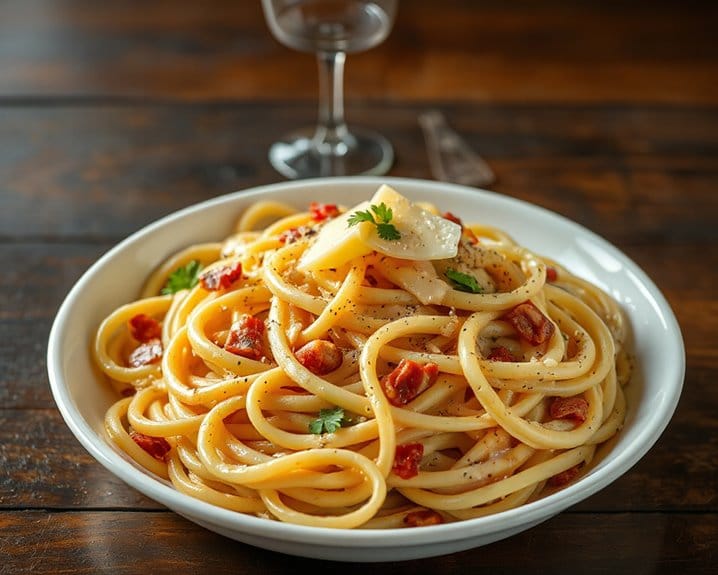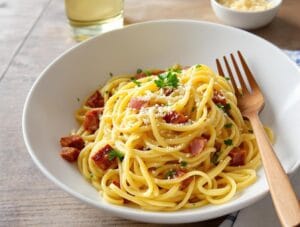Why You’ll Love this Silky Italian Carbonara
Three things make this Silky Italian Carbonara absolutely irresistible. First, the silky texture that coats every strand of pasta with a luxurious sauce made from eggs, cheese, and pasta water—never cream. Second, the perfect balance of salty pancetta that crisps up beautifully, releasing its rich flavor into the olive oil. And third, the peppery bite that cuts through the richness, making each forkful completely addictive.
What I adore about carbonara is how it transforms humble ingredients into something truly magnificent. Can you believe something this decadent comes together in less than 20 minutes? The trick lies in the technique—tempering those eggs with pasta water so they create that silky sauce without scrambling. Pure magic on a weeknight.
What Ingredients are in Silky Italian Carbonara?
Making an authentic silky Italian carbonara doesn’t require a long list of ingredients, which is precisely what makes this dish so wonderful—it’s all about quality components coming together to create something truly magical. Carbonara is the ultimate example of how simple ingredients can transform into a luxurious, creamy pasta dish without actually using any cream at all. The key is in the technique and timing, allowing the eggs to create that signature silky sauce that clings to every strand of pasta.
- 1 pound spaghetti or rigatoni pasta
- 1/4 cup extra virgin olive oil
- 1/4 pound pancetta (Italian bacon), chopped
- 1 teaspoon red pepper flakes
- 5-6 cloves garlic, chopped
- 1/2 cup dry white wine
- 2 large egg yolks
- Romano cheese, freshly grated
- Fresh parsley, for garnish
- Salt and black pepper to taste
When shopping for these ingredients, quality really does matter for carbonara. Try to find authentic pancetta if possible, though regular bacon can work in a pinch (just know it’s not quite the same). The cheese should be freshly grated—never use the pre-grated stuff in the green container, which contains anti-caking agents that will prevent it from melting properly into your silky sauce. And about those eggs: the fresher, the better, as they’re fundamentally becoming your sauce. Some traditional recipes might call for whole eggs rather than just yolks, or might use Pecorino Romano specifically rather than just Romano, so feel free to adjust based on your preference for richness and sharpness of flavor.
How to Make this Silky Italian Carbonara

To start this luscious carbonara, bring a large pot of salted water to a rolling boil and cook 1 pound of spaghetti or rigatoni pasta according to package directions.
While the pasta bubbles away, heat 1/4 cup of extra virgin olive oil in a large skillet over medium heat. Add 1/4 pound of chopped pancetta (that’s Italian bacon, folks) and let it brown for about 2 minutes until it starts to crisp up. The aroma that fills your kitchen at this point? Absolutely heavenly.
Next, add 1 teaspoon of red pepper flakes and 5-6 chopped garlic cloves to the pancetta, cooking for another 2-3 minutes until the garlic becomes fragrant but not burned. Pour in 1/2 cup of dry white wine, making sure to scrape up all those glorious brown bits from the bottom of the pan—that’s where all the flavor lives.
While that’s happening, grab a separate bowl and beat 2 large egg yolks, then gradually whisk in about 1/2 cup of the pasta cooking water. This indispensable step tempers the eggs so they’ll create a silky sauce rather than scrambling when added to the hot pasta.
For the best results when preparing this authentic dish, consider using a premium Italian cookware set that distributes heat evenly throughout your cooking process.
When the pasta is al dente, drain it well and immediately add it to the skillet with the pancetta mixture. Working quickly, pour the egg mixture over the hot pasta and toss rapidly to coat every strand without cooking the eggs. Remove the pan from heat and add a generous handful of freshly grated Romano cheese, plenty of freshly ground black pepper, and a pinch of salt. Continue tossing until the pasta absorbs the sauce completely, creating that signature silky, glossy coating that makes carbonara so irresistible. Garnish with fresh parsley before serving for a pop of color and freshness.
Silky Italian Carbonara Substitutions and Variations
While traditional carbonara is undeniably delicious, sometimes your pantry situation calls for some creative substitutions. No pancetta? Bacon works beautifully, though it’s a bit smokier than its Italian cousin. You can even use guanciale (pork jowl) for an ultra-authentic Roman experience—it’s fattier and more flavorful.
Don’t have spaghetti? Any long pasta will do—linguine, fettuccine, or even bucatini with its hollow center. For a creamier version, you might add a splash of heavy cream, though purists would gasp.
The cheese is flexible too. While Pecorino Romano is traditional, Parmesan makes a fine stand-in. And if you’re feeling adventurous, try mixing in seasonal vegetables like peas or asparagus in spring. Just remember, the soul of carbonara lies in that silky egg coating—that’s non-negotiable.
What to Serve with Silky Italian Carbonara
What exactly should you pair with a rich, silky carbonara that won’t compete with its decadence? I’m all about balance here—think crisp, acidic elements that cut through that creamy egg sauce and salty pancetta.
A simple arugula salad with lemon vinaigrette works wonders, the peppery greens and bright acidity providing perfect contrast. Roasted Brussels sprouts or asparagus, with their slight bitterness, complement the pasta beautifully. And bread? Well, a light, crusty Italian loaf is non-negotiable for sopping up extra sauce, though maybe skip the garlic butter this time.
For drinks, go with a dry white wine like Pinot Grigio or Vermentino—something crisp that’ll cleanse your palate between those heavenly, cheese-laden bites.
Final Thoughts
Now that we’ve paired our pasta perfectly, let’s wrap up this carbonara conversation.
This Roman classic is all about simplicity and quality ingredients. The magic happens in that moment when hot pasta meets egg yolks, creating that silky sauce without scrambling. Remember, authentic carbonara never includes cream – just eggs, pancetta (or guanciale if you’re being traditional), cheese, and pepper.
Don’t rush the process. Take your time browning the pancetta, and always temper those eggs with pasta water. When you’re tossing everything together, move quickly but with purpose. The residual heat does all the work for you.
Carbonara might seem intimidating at first, but once you’ve mastered this technique, you’ll have a restaurant-worthy dish in your repertoire forever. Worth every minute, don’t you think?

